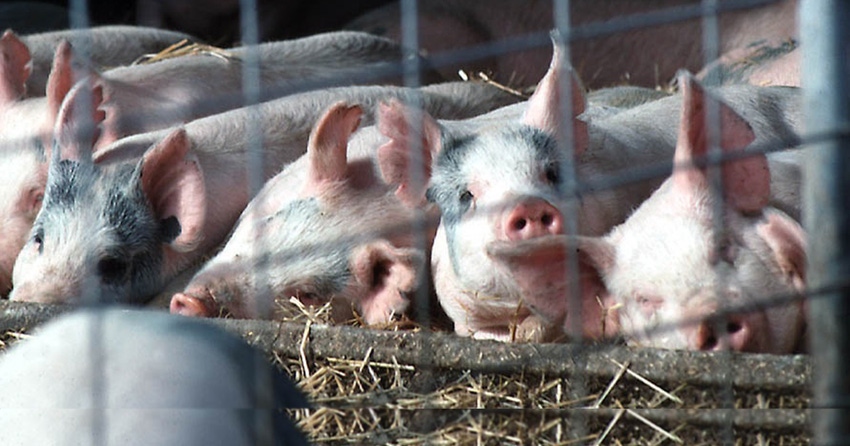
Porcine epidemic diarrhea virus, commonly referred to as PEDv, was confirmed overnight on March 21 at the 2019 Oklahoma Youth Expo, making it important to separate fact from fiction for anyone wondering what that really means to pork producers, exhibitors, the animals and the general public.
“PEDv occurs only in pigs, is not a human health risk and has no effect on food designated for human consumption,” said Dr. Barry Whitworth, Oklahoma State University Cooperative Extension veterinarian and food animal quality and health specialist. “Humans cannot catch the disease from pigs, and pork products from exposed swine are safe for consumption when properly prepared.”
The swine disease is highly infectious in pigs and produces acute and severe outbreaks of diarrhea and vomiting that can transmit rapidly to all swine in an area. PEDv can be a killer. Baby pigs age 3 weeks or younger are especially susceptible, with up to 100 percent mortality rates documented.
“Producers and exhibitors who attended the Oklahoma Youth Expo should take all recommended biosecurity measures to prevent introducing the disease into their pigs at home, especially if they have sows that have farrowed or are due to farrow,” Whitworth said.
Basic biosecurity measures include keeping pigs that have been to shows and off-farm areas isolated from the rest of the herd for no fewer than a week and up to 30 days, if possible; having dedicated boots and clothing for isolation areas; and designating tack and other equipment that will be used only for animals in isolation.
“All vehicles, trailers and equipment such as feeders, buckets and sort-boards need to be cleaned, disinfected and dried,” Whitworth said. “Use a power washer if you must. Remember, you don’t have to come in contact with infected swine to spread the disease. Walking into a contaminated area can increase the risk just as easily.”
PEDv is thought to have gone undetected at the expo for several days, meaning the swine present have possibly been exposed to the disease.
“It takes a couple of days to manifest and develop to the extent we saw,” said Roy Lee Lindsey, Oklahoma Pork Council executive director. “Our biggest concern right now is taking steps to limit the spread as best we can. People who attended the expo need to exercise extreme caution in terms of managing the risk around their livestock, most especially young piglets.”
Lindsey gave a special shout-out to the Oklahoma Animal Disease Diagnostic Laboratory on OSU’s Stillwater campus, applauding the staff’s rapid response to the PEDv presence.
“They worked through the night and into the morning hours to confirm the presence of PEDv at the expo, allowing us to make informed decisions and initiate the best possible response in the quickest manner possible,” Lindsey said.
OADDL staff confirmed the presence of PEDv from provided samples within 5 hours. The efficiency and effectiveness of the laboratory did not surprise Lindsey, who called the OADDL one of the state’s greatest resources. Laboratory staff work closely with recognized experts in OSU’s Center for Veterinary Health Sciences, Boren Veterinary Medical Hospital and the National Center for Veterinary Parasitology to provide contemporary, state-of-the-art veterinary diagnostics for veterinarians, producers, government agencies and more.
“We always stress the importance of people working closely with their local veterinarian to ensure the well-being of their animals,” said Dr. Keith Bailey, OSU veterinarian and OADDL director. “If a disease is suspected, the veterinarian then will collect appropriate samples in the approved manner and send them to our laboratory for testing.”
Bailey added even the most knowledgeable swine owner should develop a good working relationship with his or her local veterinarian. After all, it is possible diseases such as African Swine Fever or Classical Swine Fever could initially present with severe diarrhea that might be mistaken for PEDv.
“A cooperative partnership between animal owner and veterinarian really is the best bet to promote animal well-being,” Bailey said. “And remember, many animal diseases like to hitch a ride on clothing and equipment; the need to employ good biosecurity measures as a way to minimize the accidental spread of disease cannot be stressed enough.”
Additional information on PEDv and biosecurity measures is available online through the Oklahoma Department of Agriculture, Food and Forestry at http://www.ag.ok.gov/ais, and the Pork Checkoff website at http://www.pork.org/pedv. Those interested also might want to visit with their Oklahoma Cooperative Extension Service county office, typically listed in local directories under “County Government.”
The Oklahoma Cooperative Extension Service is one of two state agencies administered by OSU’s Division of Agricultural Sciences and Natural Resources and is a key part of the university’s state and federally mandated teaching, research and Extension land-grant mission.
Source: is Oklahoma State University, which is solely responsible for the information provided and is wholly owned by the source. Informa Business Media and all its subsidiaries are not responsible for any of the content contained in this information asset.
About the Author(s)
You May Also Like




